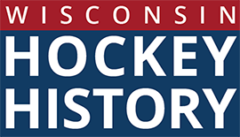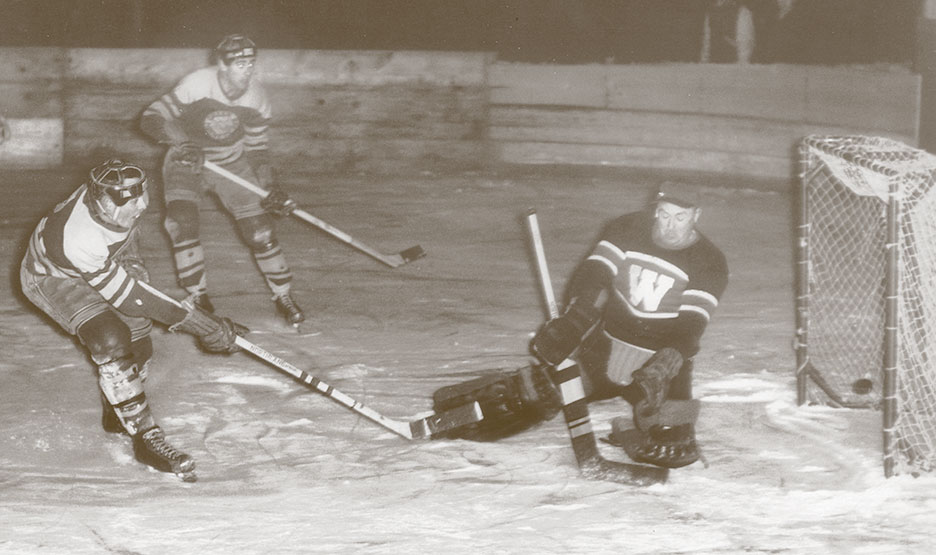Bob grew up in Green Bay during the 1930s and 40s. At age 6 or 7, his father took him to his first hockey game. His uncle was playing for the DePere Redwings against a Green Bay men’s team at Fort Howard Park. “The boards outlining the ice surface were old railroad ties,” Bob recalled.
The five Tochterman brothers – a sixth came a little bit later on – skated on the outdoor skating rink at Fisk Park. The skating rink was about ten times the size of today’s hockey rinks. In the eighth grade, Bob started playing organized hockey as he joined a city high school league. His older brother George was in the tenth grade and he led the team. Bob remembers that the city workers would flood the hockey rink at Fish Park each evening. Bob and his buddies would try to get on smooth ice early the next morning.
After World War II, a number of returning veterans, including Don Brueckner and Red Van Adestine, organized the Hornets. In 1949, when he was a junior in high school, Bob joined the team as a fourth liner. His first game was at Appleton on the rink “down in the hole.” Within the next two years, Bob emerged as the team’s leading scorer.
The Korean War interrupted his hockey-playing career. He served in the Air Force with the Strategic Air Command for four years. “But, I tried to arrange month-long military leave in the winter so I could rejoin the Hornets. That worked a couple of years. During that time, the Hornets featured five Tochterman brothers playing together. In addition, the Hornets had several other fine players such as Wayne Gladous, the Wagner brothers, the Oettinger brothers, and their goalie Pete Ellis. “Unfortunately, Ellis lost his life in the Korean War,” Bob mentioned.
While in the service, Tochterman was stationed in Florida but he traveled to England and Iceland. “In Iceland we tried to start a hockey club. We had sticks and skates but couldn’t find suitable ice.”
While playing with the Hornets, Tochterman has fond memories of games against Wausau, Madison and Fond du Lac. “We developed a good relationship and after the games usually convened at a local watering hole for a beverage and good conversation.” He does recall getting into a scrum with Don Kohlman of the Fond du Lac Bears. “We met at the blue line, exchanged a few words, dropped our gloves and then got ejected.” In later years, Tochterman and Kohlman became good friends. Mosinee was another story. “We always had battles with that team and the relationships were not friendly,” Bob recalled.
In 1952, the Hornets hosted the state tournament. “It was a mild weekend and the championship game between Madison and Camp McCoy was played in the slush. I still remember the teams trying to push the puck through the soft ice.”
When he was discharged from the service in 1956, Bob entered the work force in Green Bay and later transferred the Chicago area. He joined the Elgin Blades, a senior men’s team that dominated their league for a number of years. “The majority of the team was a group of native Canadians from Northern Ontario. Our coach was an FBI agent who was able to get jobs for them. Gene Stoneypoint was one of those Canadians. He was a smooth skater as were most of the Canadians. We had a great player from Nova Scotia and another who had played at Michigan Tech. Our goalie was from Chicago and I was from Wisconsin. One of the highlights of playing in Chicago was an occasional game in the old Chicago Stadium. We usually had three or four fans per team watching the game.” Later, the Madison Cardinals moved to the Rockton Wagon Wheel and gave the Elgin Blades some stiffer competition. “It seemed like the Wagon Wheel team imported players every other week to strengthen their squad,” Bob recalled.
In the late 1950s, Bob returned to Green Bay where he enrolled at St. Norbert College and worked full time at Pranges department store. Studying, working and raising a family forced Bob to give up his playing career, but not hockey.
By this time, the Green Bay Bobcats who played out of the Brown County Arena became the premier hockey attraction in the area. Bob’s brother Tom played goal for the Bobcats for the first two seasons. Most of the players, though, were imported. The Bobcats became one the top men’s teams in the country. The Hornets became a high school program.
Once he graduated from St. Norbert and resumed his sales career, Bob became involved in the area’s youth hockey programs. Bob and four others – Orv Stankevitz and George Wrobel (former Hornet teammates) and Larry Belonger and Bill Steeno organized the Brown County Youth Hockey Association. At the time, this youth association received 72 hours of ice at the Brown County Veterans Memorial. That was less than twenty hours a week; not enough for their growing program. So Bob and a few other veterans approached the County Board requesting more ice time. The request was honored and 270 hours of ice time was allotted to the youth program.
From those early years at the Brown County Arena, several hockey players were developed who went on the play college hockey. Two of the first were Mike Gleffe and the sixth Tochterman brother, Matt, who both played varsity hockey at the University of Wisconsin the late 1960s.
In the late 1960s, Bob also coached youth hockey for a few years. He recalled that his squirt team lost 6-4 to a Madison team coached by Marlowe Suter. That team had Bob Suter and the two Johnson brothers on it – Mark and Pete.. They also had an outstanding defenseman. Bob mentioned to Marlowe Suter that his defenseman was such a solid player. “He’s actually a speed skater,” Suter responded. “Well, tell his mom and dad that he should stick to hockey,” Bob retorted. That defenseman was a kid named Eric Heiden.
In the early 1970s, Tochterman became heavily involved in the building and development of the Brown County Youth Hockey Arena. Fort Howard Corporation donated $400, 000 for the building. When the first rink manager fell short of expectations, Bob assumed much of that responsibility. Bob, along with Mike Goyermac, was instrumental in founding the Ashwaubenon Hockey Association. Bob’s three sons – Mike, Bill, and Jerry played in that program.
The Brown County Youth Arena produced a large number of college players including Mark Mazzoleni, Gary Harpell, Kevin Humpreys, Dan Gerarden and Greg Poss and others. In the mid 1990s, the Green Bay Packers needed the land for their program, so the ice arena was purchased and that money helped build the current three-sheet facility known as the Cornerstone Ice Arena.
In his sixties, Bob returned to the ice playing in the old timers league with his younger brother, Matt, and his three sons. He finally retired a couple of seasons ago when he turned 80. Today, he follows his alma mater, St. Norbert and their successful men’s program. His son Jerry is the team’s stick man.
Photo: Jim Tochterman (foreground) and Bob Tochterman (background)

